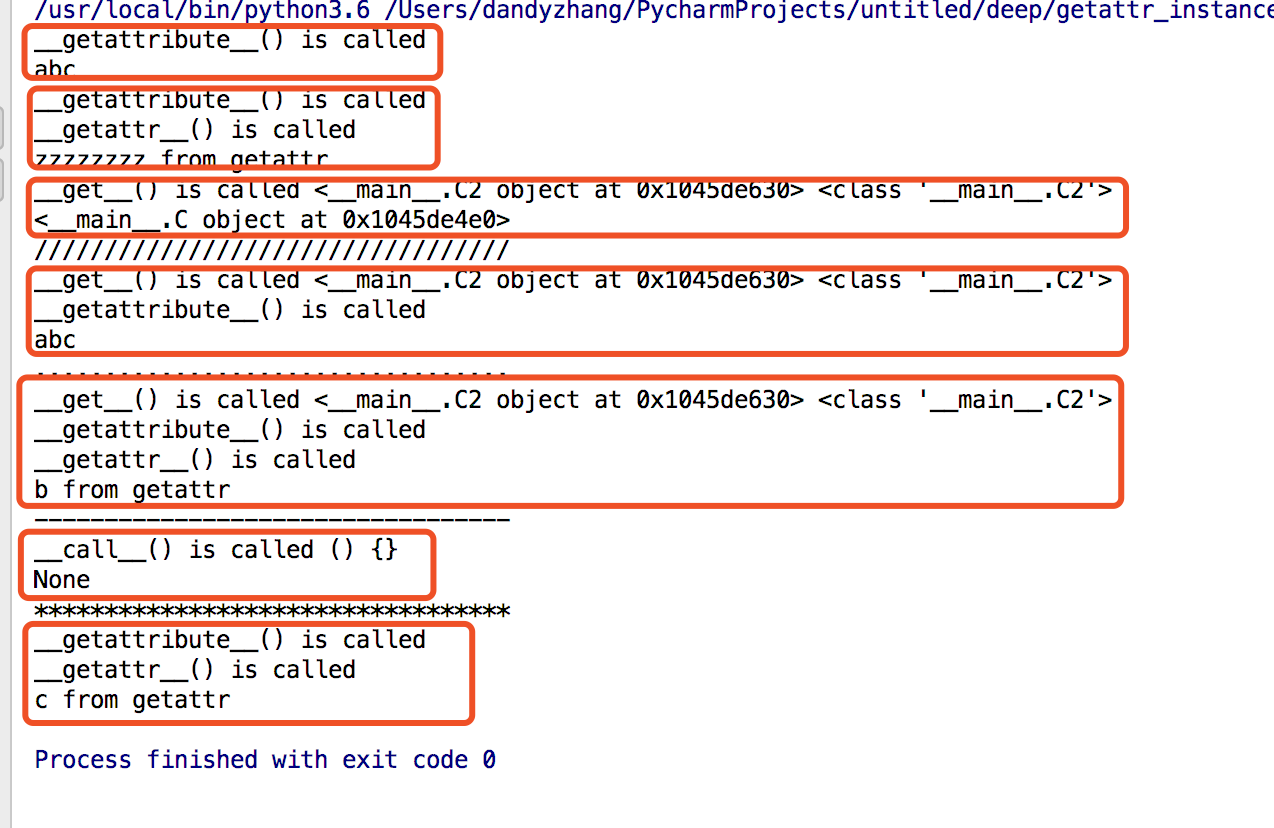Python中__get__, __getattr__, __getattribute__的区别及延迟初始化
本节知识点
1、__get__, __getattr__, __getattribute__的区别
2、__getattr__巧妙应用
3、延迟初始化(lazy property)
1、__get__, __getattr__, __getattribute__的区别
obj.__getattribute__(self, name)
在实例访问属性的时候无条件被调用。如果class中定义了__getattr__(),__getattr__()也不会被调用,除非显示的调用或者没有访问到属性引发AttributeError异常
obj.__getattr__(self, name)
当一般位置找不到属性时,会调用__getattr__()返回一个值,如果不存在__getattr__()方法则会引发AttributeError异常。
obj.__get__(self, instance, owner)
如果类定义了它,则这个类可以被称为descriptor(描述符),owner是所有者的类,instance是访问descriptor的实例,如果不是通过实例访问,而是通过类访问的画,instance则为None。
descriptor的实例自己访问自己是不会触发__get__,而会触发__call__,只有descriptor作为其它类的属性才有意义。
类里面是默认不会提供__get__()方法的
class C: a = 'abc' def __getattribute__(self, *args, **kwargs): print("__getattribute__() is called") # print(1, object.__getattribute__(self, *args, **kwargs)) return object.__getattribute__(self, *args, **kwargs) def __getattr__(self, name): print("__getattr__() is called") return name + " from getattr" def __get__(self, instance, owner): print("__get__() is called", instance, owner) # instance 是访问desciptor的实例 return self def foo(self, x): print(x) def __call__(self, *args, **kwargs): print('__call__() is called', args, kwargs) class C2: d = C() if __name__ == '__main__': c = C() c2 = C2() print(c.a) # 1、__getattribute__() is called 2、abc 先调用__getattribute__()方法,然后获取属性 print(c.zzzzzzzz) # 1、__getattribute__() is called 2、__getattr__() is called 3、zzzzzzzz from getattr print(c2.d) # d是C类的实例,而C因为存在__get__()方法,而变成描述符,访问文件描述符的实例的时候,默认应该是不走__getattribute__方法,所以也就更不可能调用到__getattr__()方法 # 1、__get__() is called 2、C2 object 3、C2 4、d指向的实例C object print('//////////////////////////////////') print(c2.d.a) # 同上面一样会先获取d,走__get__()方法,然后获取a属性的时候又会走__getattribute__ # 1、__get__() is called 2、C2 object 3、C2 4、__getattribute__ 5、abc print('..................................') print(c2.d.b) # 继续上面的逻辑,是描述符,到获取b属性,没有找到走__getattr__()方法返回 # 1、__get__() is called 2、C2 object 3、C2 4、__getattribute__ 5、__get__ 6、b from getattr print('----------------------------------') print(c()) # 实例本身调用是调用的call方法 print('**********************************') print(c.c) # 非文件描述符的还是老思路 getattribute==>getattr # 1、__getattribute__ 2、__getattr__ 3、c from getattr

参考:https://www.cnblogs.com/saolv/p/6890645.html 并做了简单修改
__getattr__应用
根据上面的介绍大概可以发现__getattr__函数的作用
在进行属性查找事,如果在实例跟类上都查找失败的时候,就会走到__getattr__函数上,如果没有定义这个函数,就会抛出AttributeError异常。所以,这里大概我们可以人为__getattr__方法是属性查找的最后一个关卡。
示例1
很简单的示例,通过__getattr__像访问属性一样访问键值对
class ObjectDict(dict): def __init__(self, *args, **kwargs): super().__init__(*args, **kwargs) # 继承父类dict的构造方法 def __getattr__(self, name): value = self[name] # self ==> {'asf': {'a': 1}, 'd': True} if isinstance(value, dict): value = ObjectDict(value) return value if __name__ == '__main__': od = ObjectDict(asf={'a': 1}, d=True) # 实例化对象od ==> {'asf': {'a': 1}, 'd': True} print(od.asf) # {'a': 1} print(od.asf.a) # 1 print(od.d) # True
实例化对象od,通过.attribute的方式来获取key对应的value
示例2
class WidgetShowLazyLoad: def fetch_complex_attr(self, attrname): return attrname def __getattr__(self, name): if name not in self.__dict__: # 没在__dict__字典内找到key self.__dict__[name] = self.fetch_complex_attr(name) # 添加attribute键值对 return self.__dict__[name] if __name__ == '__main__': w = WidgetShowLazyLoad() print('before', w.__dict__) # 刚开始实例化的时候,__dict__是空的字典 w.lazy_loaded_attr # 属性查找,没找到,调用__getattr__方法 print('after', w.__dict__) # {'lazy_loaded_attr': 'lazy_loaded_attr'}
结果:
before {} after {'lazy_loaded_attr': 'lazy_loaded_attr'}
这里的核心,就是利用了__getattr__属性的机制,在查找不存在的属性的时候进行改写,动态懒加载出来一个字典。这个例子就是类实例的惰性初始化
示例3
import functools class lazy_attribute: """ A property that caches itself to the class object. """ def __init__(self, func): functools.update_wrapper(self, func, updated=[]) self.getter = func # complex_attr_may_not_need def __get__(self, obj, cls): # 调用类本身, obj自身调用为空 value = self.getter(cls) # complex_attr_may_not_need(Widget) setattr(cls, self.__name__, value) # self ==> complex_attr_may_not_need=lazy_attribute(complex_attr_may_not_need) # self 所以是lazy_attribute的对象,装饰器的原理就是complex_attr_may_not_need=lazy_attribute实例化对象,所以self.__name__就是complex_attr_may_not_need # {'complex_attr_may_not_need': 332833500} return value class Widget: @lazy_attribute # complex_attr_may_not_need=lazy_attribute(complex_attr_may_not_need) def complex_attr_may_not_need(clz): print('complex_attr_may_not_need is needed now') return sum(i*i for i in range(1000)) if __name__ == '__main__': print(Widget.__dict__.get('complex_attr_may_not_need')) # <__main__.lazy_attribute object at 0x02B12450> Widget.complex_attr_may_not_need # complex_attr_may_not_need is needed now print(Widget.__dict__.get('complex_attr_may_not_need')) # 332833500
上面的代码里面,用到了一个类装饰器,它的使用其实也还没没有离开装饰器的基础定义,被装饰的函数相当于
complex_attr_may_not_need=lazy_attribute(complex_attr_may_not_need)
这相当于实例化了这个函数,所以可以发现,__init__方法内有一个func参数。
functool.update_wrapper
使用update_wrapper(),从原始对象拷贝或加入现有对象
它可以把被封装函数的__name__、__module__、__doc__和 __dict__都复制到封装函数去
所以上述过程的执行流程可以理解为:
1、print(Widget.__dict__.get('complex_attr_may_not_need'))
此方法实际上是获取Wdiget方法的__dict__字典内的complex_attr_may_not_need的key,但是因为complex_attr_may_not_need这个方法被类装饰器lazy_attribute装饰(装饰器的本质,其实就是把被装饰的方法传进去),所以此时的结果应该是指向lazy_attribute的实例化对象的。
2、Widget.complex_attr_may_not_need
首先需要注意的是,这个方法传入的参数complex_attr_may_not_need(clz)。类装饰器初始化的时候,传入了func就是被装饰的方法,并赋值给了实例属性getter,此时lazy_attribute里面有__get__()方法,所以lazy_attribute是一个描述符descriptor。因为是外部的Widget类调用的complex_attr_may_not_need方法,所以此时会先运训__get__方法。value = self.getter(cls),其中self.getter=func即complex_attr_may_not_need方法,cls是调用的类本身即Widget,变成value = self.complex_attr_may_not_need(Widget),执行此方法,打印出complex_attr_may_not_need is needed now,value=计算的和,并内部设置了Widget类的complex_attr_may_not_need对应的value为计算和。
3、print(Widget.__dict__.get('complex_attr_may_not_need'))
现在这一句就很好理解了,取值并打印。
关于setattr不理解可以看下下面随手写的案例
class Foo: def __init__(self): setattr(Foo, 'aaa', 'bbb') def aaa(self): return 'a' f = Foo() print(Foo.__dict__)
执行一次,再把f = Foo()注释掉执行一下,看看aaa的值就知道了。
实例4
class adaptee: def foo(self): print('foo in adaptee') def bar(self): print('bar in adaptee') class adapter: def __init__(self): self.adaptee = adaptee() def foo(self): print('foo in adapter') self.adaptee.foo() def __getattr__(self, name): return getattr(self.adaptee, name) if __name__ == '__main__': a = adapter() a.foo() # 1、foo in adapter 2、foo in adaptee a.bar() # 1、bar in adaptee
执行a.foo()应该是没什么问题的,顺序执行而已,但是在执行a.bar()的时候,因为adapter里面没有此属性,所以会走到最后一道关卡__getattr__方法,所以就很好理解了。
__getattr__使得实现adapter wrapper模式非常容易,我们都知道“组合优于继承”,__getattr__实现的adapter就是以组合的形式。
实例5
class AlgoImpA: def __init__(self): self.obj_attr = 'obj_attr in AlgoImpA' def foo(self): print('foo in AlgoImpA') def bar(self): print('bar in AlgoImpA') class AlgoImpB(object): def __init__(self): self.obj_attr = 'obj_attr in AlgoImpB' def foo(self): print('foo in AlgoImpB') def bar(self): print('bar in AlgoImpB') class Algo: def __init__(self): self.imp_a = AlgoImpA() self.imp_b = AlgoImpB() self.cur_imp = self.imp_a def switch_imp(self): if self.cur_imp == self.imp_a: self.cur_imp = self.imp_b else: self.cur_imp = self.imp_a def __str__(self): return 'Algo with imp %s' % str(self.cur_imp) def __getattr__(self, name): return getattr(self.cur_imp, name) if __name__ == '__main__': algo = Algo() # imp_a print(algo) # Algo with imp IMPA print(algo.obj_attr) # obj_attr in AlgoImpA algo.foo() # foo in AlgoImpA algo.switch_imp() print(algo) # Algo with imp IMPB print(algo.obj_attr) # obj_attr in AlgoImpB algo.bar() # bar in AlgoImpB
3、延迟初始化(lazy property)
概念
Python对象的延迟初始化是指,当它第一次被创建时才进行初始化,或者保存第一次创建的结果,然后每次调用的时候直接返回结果。
延迟初始化主要是用于提高性能,避免浪费计算,并减少程序的内存需求。
property
首先,再来回顾下property的用法,property可以将属性的访问转变成方法的调用
class Circle(object): def __init__(self, radius): self.radius = radius @property def area(self): return 3.14 * self.radius ** 2 c = Circle(4) print(c.radius) print(c.area)
area被定义成一个方法的形式,但是加上@property后,可以直接用c.area来调用,当成属性访问。
但这样写面临的一个问题就是,每次调用c.are都会去计算一次,浪费cpu,怎么养才能只计算一次呢?这就是延迟初始化lazy property
lazy property
这里,我们趁热打铁,使用文件描述符来来实现。
class lazy(object): def __init__(self, func): self.func = func def __get__(self, instance, cls): val = self.func(instance) setattr(instance, self.func.__name__, val) return val class Circle(object): def __init__(self, radius): self.radius = radius @lazy def area(self): print('evalute') return 3.14 * self.radius ** 2 c = Circle(4) print(c.radius) print(c.area) print(c.area)
结果:
4
evalute
50.24
50.24
可以发现evalute只输出一次。在lazy类里面,因为定义了__get__()方法,所以它是一个描述符。当第一次执行c.are时,python解释器会先从_c._ditc__中查找,没有找到就会去Circle.__dict__中进行查找,这个时候因为area被定义为描述符,所以调用__get__方法。
上面已经铺垫过def __get__(self, instance, cls)里面三个参数的代表什么,所以很明了val = self.func(instance) ,是执行了area方法,并返回结果,最后setattr完成了赋值操作。这样相当于设置c.__dict__['area']=val。
当我们再次调用c.area时,直接从c.__dict__中进行查找,这时就会直接返回之前计算好的值了。
这里再提供另一种方法
def lazy_property(func): attr_name = "_lazy_" + func.__name__ @property def _lazy_property(self): if not hasattr(self, attr_name): setattr(self, attr_name, func(self)) return getattr(self, attr_name) return _lazy_property class Circle(object): def __init__(self, radius): self.radius = radius @lazy_property def area(self): print('evalute') return 3.14 * self.radius ** 2 c = Circle(4) print("before first visit") print(c.__dict__ ) c.area print("after first visit") print(c.__dict__)
结果:
before first visit {'radius': 4} evalute after first visit {'radius': 4, '_lazy_area': 50.24}
表示,其实楼主也还是不太懂,等看明白了再来注解。
参考自http://python.jobbole.com/85553/





